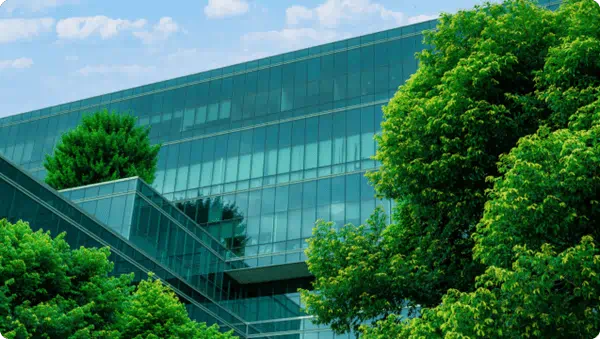My choice to pursue a sustainability-focused education was driven by a fundamental belief that change begins at the individual level. I hoped that by the time I graduated, we’d have a clearer understanding of 'how' to address climate change issues. However, what became clear to me is that there’s no one-size-fits-all solution to such a monumental challenge. Fortunately, each of us has the power to contribute to positive change, and you don't need a degree in sustainability to do so.
Building a sustainable future

The built environment currently stands as one of the largest contributors to carbon emissions, accounting for over 67% of global greenhouse gas emissions. But why do our buildings harm the environment?
First, when we clear the land to make way for development, we destroy wildlife habitats and transform pre-existing permeable soil into impermeable surfaces, which disrupts natural water absorption and increases runoff, leading to soil erosion, water pollution, and increased flood risk. Second, the manufacturing of building products pollutes water and air, releases toxic chemicals, and emits greenhouse gases. Furthermore, during the building operations phase, buildings consume energy, increasing greenhouse gas emissions and adding to potable water consumption, which later becomes waste. And these are just a few of the environmental impacts—the list seems endless, and there's not a single building in the world that doesn't have some effect on the environment.
If we don't address this issue, the consequences for our planet will be dire. From worsening air quality to more frequent extreme weather events, the impacts on our environment and our communities will touch every aspect of our lives as we know them today. That being said, how we build can significantly contribute to reducing this impact.
While many solutions, such as energy-efficient HVAC systems, renewable energy integration, and sustainable building materials, aim to reduce the carbon impact of the building sector, the most challenging hurdle has been budgeting. How can we implement these solutions if there's no money to support them? Many companies hesitate to invest in sustainable alternatives due to fears that upfront costs will outweigh long-term benefits. We need to change this perspective. Sustainability should be seen as an investment in our future rather than an expense.
Building a sustainable future

It's crucial to emphasize the importance of integrating sustainable design solutions and effectively communicate the significance of climate-focused projects. This involves highlighting not only the environmental impact but also the long-term benefits of climate-strengthening investments.
We can contribute to this mission by performing life cycle assessments, conducting ESG due diligence, achieving green building certifications, and supporting our clients' carbon reduction goals. As a result of implementing these services, I’ve personally seen significant reductions in emissions and the overall life cycle impact of our projects.
Exploring practical solutions:
Now that we've discussed the importance of integrating sustainability into our projects, let's explore some practical ways we can make it happen.
-
1. Life cycle cost analysis (LCCA)
We use life cycle cost analysis to evaluate the long-term costs and benefits of sustainable design options. Since assets within the construction industry are designed to last around 30–70 years, the relevance of future costs and their certainty is essential to evaluate, especially since the operation and maintenance of an asset can be approximately three times greater than the initial design and construction. This means considering everything from construction to maintenance expenses over the building's lifetime, which helps us make informed decisions that prioritize net zero solutions.
-
2. Integrated design process (IDP)
We start early in the design phase with an integrated design process. This allows us to find opportunities for energy efficiency and renewable energy integration, making sure our buildings perform well while minimizing costs.
-
3. Value engineering
Value engineering is about finding the best functionality at the lowest cost. When we apply this to sustainability, it means identifying cost-effective solutions that still meet our net zero goals.
-
4. Financial incentives and grants
There are plenty of financial incentives and grants available for businesses investing in sustainable practices. Many municipalities also offer structural or financial incentives to developers and homeowners who implement green building techniques. By taking advantage of these opportunities, we can offset initial costs and speed up the adoption of net-zero solutions.
By implementing these solutions into our existing projects, we not only ensure cost efficiency but also enhance the resilience and sustainability of our buildings, benefiting both our clients' bottom line and mitigating long-term risks associated with climate change.
While the long-term benefits of these services include reduced operational costs and future-proofing investments, the importance of budget constraints is acknowledged. During my time at Arcadis, I've seen the challenges our clients face in balancing sustainability goals with budget limitations. Our industry must position the services that integrate sustainability as essential investments rather than optional add-ons. By integrating them into existing offerings, we not only help our clients strike this balance but also ensure sustainability remains a core part of every project.
Encouraging clients to invest in our sustainability services means offering them more than just a solution—it’s about creating long-term value for businesses and communities. From ESG due diligence to life cycle assessments, achieving green building certifications, and supporting carbon reduction goals, we can provide answers to the age-old question of 'what actions can we take?'






